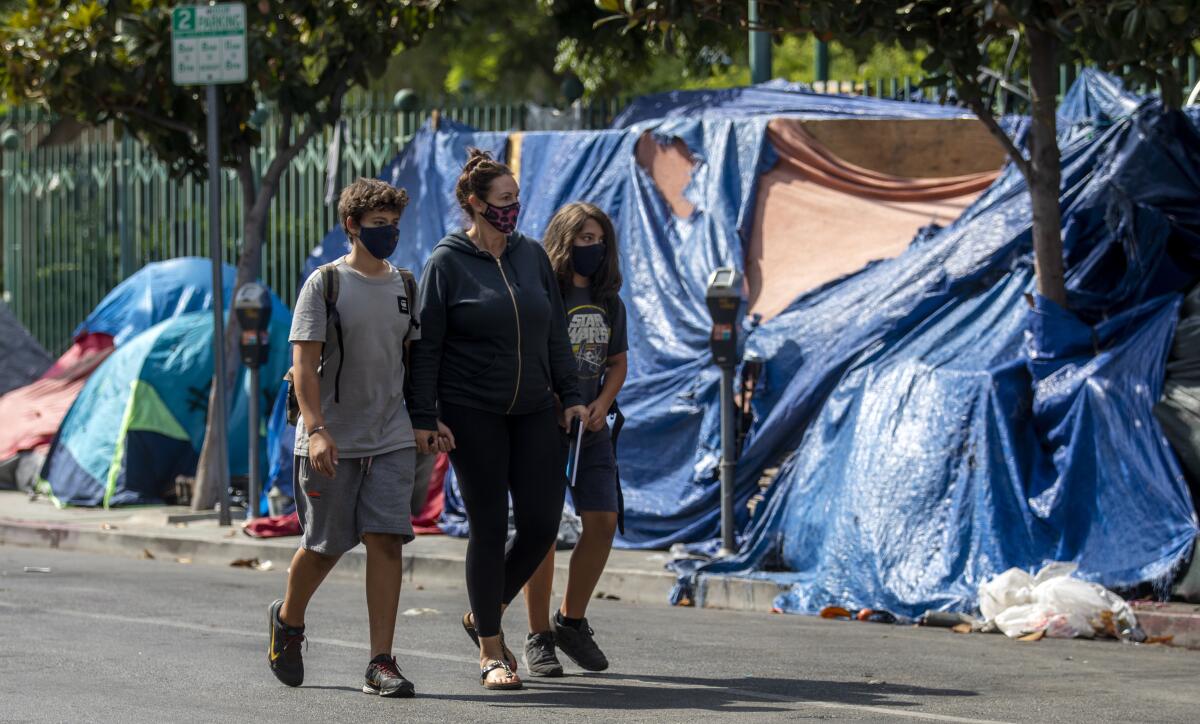Ban encampments near schools? Another L.A. restriction that doesn’t help fix homelessness

- Share via
Last week the Los Angeles City Council substantially increased the amount of public space that will be off-limits to homeless encampments when it passed an ordinance barring people from setting up tents within 500 feet of all schools — public and private — as well as day-care centers.
Under pressure from the superintendent of the Los Angeles Unified School District, the council voted 11 to 3 to expand the city’s prohibition on camping to public spaces around schools. How many schools and day-care centers will be included and how the prohibition will be enforced is unclear.
Whatever the impact of those encampments may be, enforcing a ban on setting up tents near schools does nothing to alleviate the bigger, always looming problem of homelessness.
It’s great to be able to house an entire homeless encampment. But it should be done for reasons of public access and safety, not to placate whichever neighborhood complains the loudest.
And this is hardly the time to displace more people. For years, the city has failed to create enough permanent housing to make a dent in its homeless population, which by a 2020 count was about 41,000 people. Nor is there enough temporary housing, despite increases in the number of bridge shelters, motel and hotel rooms and villages of tiny homes. The majority of the city’s homeless population sleep outside on any given night.
Plus, the city is expecting to lose more than 1,000 hotel rooms that were set aside for vulnerable homeless people through a program called Project Roomkey. The city rented hotels and motels that were otherwise vacant as the COVID-19 pandemic raged, but now hotels are exiting the program. City officials are scrambling to find other housing for people who must leave those hotels. One hotel recently ended its participation in the program. Another three are slated to end their participation this month or next, but city officials are now working to keep them in the program until the end of October.
Even when there is funding for housing, the city is failing to ensure homeless people can find apartments. Los Angeles received more than 3,300 federal emergency housing vouchers last year, but the great majority of the voucher holders had yet to find a place to live as of last month, according to an L.A. Times report. Other California cities have had far higher rates of success housing people with the vouchers, although Los Angeles is a hugely competitive, under-supplied rental market.
The city’s settlement with the L.A. Alliance for Human Rights leaves the most vulnerable homeless people on the street. That’s absurd.
When the council decided a year ago to begin enforcing anti-camping restrictions, it agreed to do targeted enforcement. First, a council member had to submit locations for approval by the council. Then, as part of a street engagement strategy, outreach teams had to be dispatched to those locations and offer people shelter. Finally, signs had to be posted announcing that camping was prohibited as of a certain date. Over the past year, the council designated 225 sites with a camping prohibition. Of those, 28 are near schools and five are near day-care centers.
But the policy hasn’t worked as promised; there hasn’t been enough interim housing and there aren’t enough outreach workers to do the engagement, city officials and service providers have said. And the ban on camping is not being enforced consistently.
Now, the city is choosing to wield the anti-camping ordinance like a blunt instrument. The prohibition passed last week requires no street engagement or time frame for beginning enforcement. It doesn’t even require posting of signs indicating where the 500-foot-ban around schools begins.
This is a huge expansion of anti-camping bans without a commensurate expansion of services and housing. There are 750 L.A. Unified schools within the city of L.A. (About 120 have had encampments near them in the last year, according to school officials.) But that doesn’t take into account the number of private schools and day-care centers. Councilman Mike Bonin, who voted against the ban along with Councilmembers Nithya Raman and Marqueece Harris-Dawson, predicted the changes would result in a roughly tenfold increase in the number of outlawed sites, going from more than 200 to about 2,000. Accountant Kenneth Mejia, a candidate for city controller and critic of the camping restrictions, mapped the roughly 1,900 public and private schools and day-care centers in commercial areas and estimated this ban would make 20% of the city’s sidewalks off-limits to camping.
Even an aide to a council member who voted for the amendment admits this is only about restricting camping and not about fixing homelessness. “The intended purpose is to keep the area around the schools clear,” he told an editorial writer. “The best we are going to be able to do is say, ‘Hey, move down the block, just don’t camp in front of the school.’”
The City Council may think it’s responding to constituents’ anger at having to walk past people camped on sidewalks, but the new restrictions only fool people into thinking something is being done about homelessness. This restriction won’t make a dent in homelessness and it probably won’t even reduce the appearance of encampments. It will simply shift them down the block from a school — and it might not even do that. Another anti-camping restriction wastes time and city resources and solves nothing.
More to Read
A cure for the common opinion
Get thought-provoking perspectives with our weekly newsletter.
You may occasionally receive promotional content from the Los Angeles Times.











